When Wisconsin repealed its state Complete Streets policy in 2015, the City of Milwaukee jumped on the opportunity to adopt its own city-level policy, crafting a strong resolution in 2018. Despite strong annual reports designed to track progress, the city continues to face numerous staffing and capacity challenges, but city staff and local advocates remain committed to achieving the vision outlined in their policy.
While our Best Complete Streets Policies Report recognizes the best, most recent policies, what happens as the years go by? In these profiles, we look back at strong policies that Smart Growth America recognized in previous reports and hear from advocates and city leaders about what worked, what didn’t work, why, and even more lessons they learned along the way.

Background
The largest city in the state of Wisconsin, Milwaukee, is located on the western shore of Lake Michigan and embodies its moniker, “a Great Place on a Great Lake.” With a little over half a million residents, the dynamic city is known for its liveliness, close-knit creative community, and lakefront museums. However, this bustling city faces challenges with traffic safety. From 1996 through 2013, traffic crashes typically killed 30 to 40 people in Milwaukee every year, but these numbers started to get increasingly worse over the last decade. There were 32 annual traffic fatalities reported in 2013, which were up to nearly 90 by 2020, with a majority of these fatalities affecting pedestrians, bicyclists, and motorcyclists. The city is committed to working toward reversing this trend.
In 2018, the National Complete Streets Coalition reevaluated what makes a good Complete Streets policy, creating a new grading framework that increased the focus on implementation and put equity at the center of what makes a good policy. While most policy scores went down due to the stricter criteria, Milwaukee’s policy was recognized as one of the 10 best we evaluated in 2018, meeting these new, higher standards and demonstrating their commitment to providing safe access to destinations. When interviewed by the National Complete Streets Coalition in 2018, James Hanning, who at the time was the Pedestrian and Bicycle Coordinator at the Department of Public Works (DPW), said of their Complete Streets policy: “Ours was originally ‘Frankensteined’ from a whole bunch of other policies and ended up being edited to fit Milwaukee. We don’t have to reinvent the wheel—there is a lot of great stuff already out there.”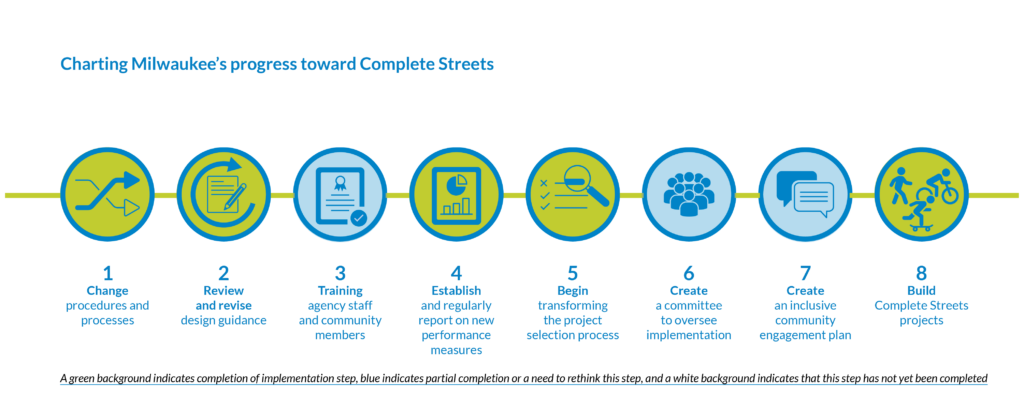
Milwaukee’s Complete Streets journey
The City of Milwaukee adopted a formal Complete Streets policy in 2018 (Resolution #180922), but the city was already in the process of building infrastructure projects that incorporated Complete Streets elements under its Bicycle Plan (adopted in 1993, revised in 2010) and Wisconsin’s state-level Complete Streets policy. However, in 2015, the Wisconsin state legislature chose to repeal that policy, citing “reduction of the regulatory burden on the DOT and costs” as the main reason. Although it was a disappointing move, the state repeal of its Complete Streets policy created an opportunity for the city’s DPW to develop a more context-sensitive policy at the municipal level. Ultimately, the Complete Streets resolution was a joint effort between the DPW and the Wisconsin Bike Fed.
Based on SGA’s scoring for policies passed in 2018, Milwaukee’s resolution was identified as one of the top three. The resolution was solid overall and was notable for emphasizing a context-sensitive design approach, requiring annual reports on identified safety and mode-share metrics, and passing an ordinance creating an oversight committee (#180914) including both city staff and people representing outside partner organizations. Although the committee’s operations came to a halt in 2020 due to limited clarity on operations and function, the city has done a tremendous job of publishing annual reports since 2019. (See the latest report here). Public annual reports like these are vital for strong Complete Streets efforts because they track the impact of the policy, can be a good way to evaluate success on an ongoing basis and maintain transparency between the implementers and the community.
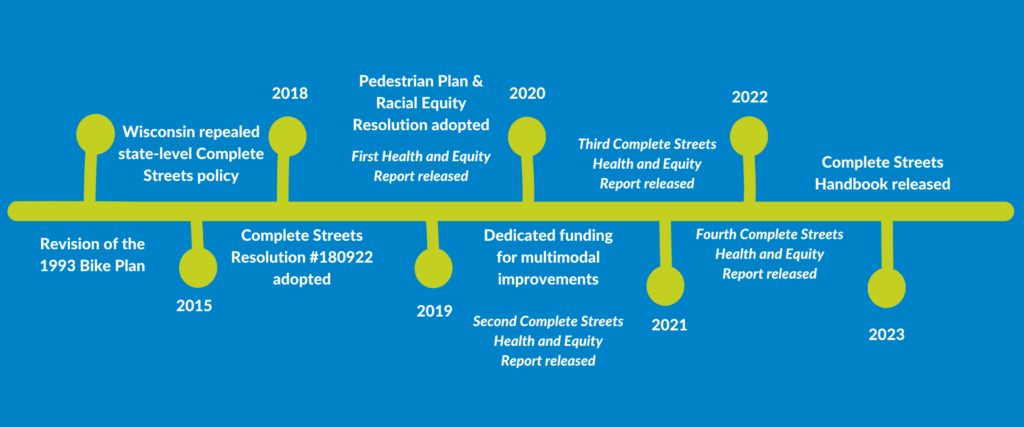
With this new strong policy in hand, Milwaukee turned its attention to putting the policy into practice. In 2019, the city adopted its first Pedestrian Plan, a product of community engagement conducted in 2017 and 2018. In other parallel efforts, Milwaukee County adopted a Racial Equity resolution in 2019, declaring racism a public health crisis. The following year, in 2020, DPW proposed $700,000 in new, dedicated funding for multimodal improvements to be used for implementing the Complete Streets policy, which was approved and later amended by an additional $500,000 specific to multimodal improvements and $110,000 dedicated towards reckless driving initiatives, a milestone in itself (2019 Health and Equity report, pg 10). Despite these local changes and having a strong local policy on the books, Milwaukee continues to face challenges with dangerous state-owned roads, partnering with the state DOT to improve safety on them.
An important part of implementing a policy is measuring progress in ways that the public can track. What’s being done? How is success being measured? (This is element #8 of a strong policy.) To track that progress—or lack of it—Milwaukee has published four Health and Equity reports so far using a range of mode-share, safety, and infrastructure metrics as well as perception surveys. Also included in these reports is information about changes to internal agency processes and project case studies. All data is separated and reported by their Neighborhood Revitalization Strategy Areas (NRSAs), which are lower-income census tracts as defined by the city.
These reports are a great example of showing the status of Complete Streets work and impact in the community over the years—and their perception surveys are particularly worth applauding. Most cities shy away from collecting qualitative data but Milwaukee not only collected the data through postcards and online surveys to understand safety, fear, and comfort of using different modes, but created easy-to-understand graphics from the results. The results show a distinct difference in perceptions of community members using different modes within the NRSAs and outside of those neighborhoods, highlighting the need to invest in these neighborhoods more proactively. (Element #2 of a strong policy).
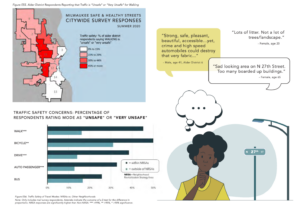

Other critical to-dos that the policy called for, such as their Complete Streets Handbook, were delayed by the pandemic and the resulting staffing and capacity challenges that so many cities faced in 2020 and beyond. Ultimately released in the winter of 2023, Milwaukee’s Complete Streets Handbook guides and revises internal processes that decide which projects get prioritized and funded to incorporate Complete Streets elements. This was released along with a Complete Streets Workbook for project managers to guide them through the project development process for implementing Complete Streets.
Despite the loss in momentum during COVID-19, the conversations and engagement that happened during the process of policy development were key to getting partners familiar with and connected to the concept of Complete Streets and educating them on how it can be used to improve safety and quality of life in communities. While the progress may have been slower than originally intended, there is reflection on challenges and ongoing work to get the city’s pace back on track with some momentum on project implementation. One example of a project that recently started construction is the West Walnut Street Replacement Project, which will add sidewalk-level bike lanes and raised crosswalks on a high-crash corridor, slowing speeds and making space by reducing driving lanes from four to two.
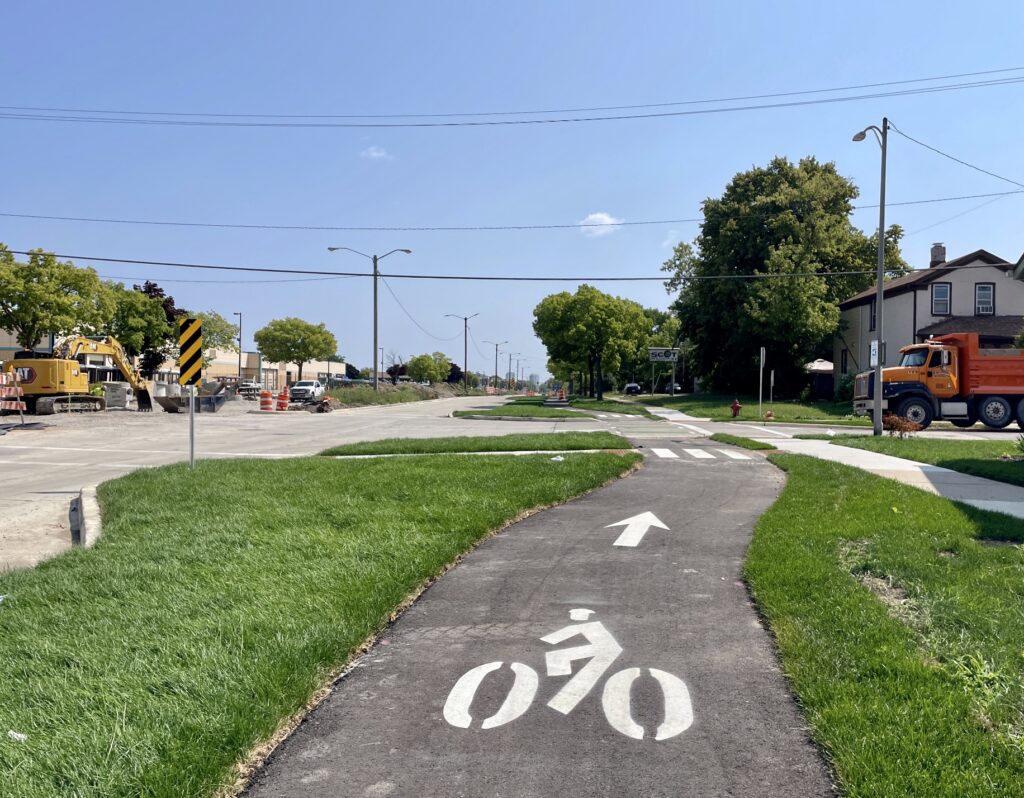
Why Milwaukee believes its policy matters
Based on our conversation with city staff and a local advocate, below are some benefits and impacts seen following the adoption of Milwaukee’s strong Complete Streets policy:
1. Digestible and publicly available annual reports are vital to understanding the city’s work and progress on Complete Streets.
The annual Health and Equity reports—which include reporting on the metrics discussed above—showed a committed effort by the DPW to report publicly and be transparent about their transportation investments and their impact on people using different modes to get around the city. Consistent formatting and sections in the report also make it easier for non-expert staff and community members to understand the information discussed, which is applauded by advocates and peer communities. Although the reports currently are a standalone snapshot in time, with the development of a project prioritization matrix through the Complete Streets handbook, the city hopes to use the extensive data it gathers and reports on to make crucial decisions.
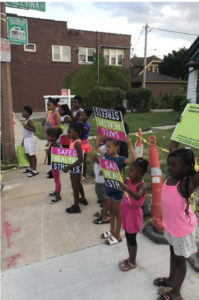
2. The process used to pass a strong policy lays essential groundwork for putting that policy into practice.
The work that goes into passing a strong policy—engaging the community and building a coalition, educating everyone, raising awareness—also builds the foundation for putting the policy into practice. Milwaukee’s Complete Streets policy was a result of partnerships between the city, advocates, and multiple local partners. This process of getting other agency partners connected to the concept of Complete Streets while developing the policy can be beneficial in the long run. Having strong advocacy and community partnerships can also help hold agencies accountable when leadership and staff turnover happens and can support the momentum of the policy.
“It’s an okay policy, what makes it strong is the people who uphold it,” says Caressa Givens, who is the Milwaukee Program Manager at the Wisconsin Bike Fed. Concerning staff capacity being a challenge in Milwaukee, she added that “local advocates who are champions in their own neighborhoods were able to leverage relationships with champions at the city to identify what they can achieve together, realistically.”
Source: Milwaukee’s 2019 Annual Report
What lessons can we learn from Milwaukee’s journey
It is important to remember that Complete Streets work is contextual to each community, and often what works in one community may not work in another. Consistent efforts, some of which may not yield the results as expected, to find the right solutions that fit your community’s needs is a true marker of success.
“Build that base of community advocates and let them lead some of the process so you’re not just passing a policy that nobody knows about. Think through implementation and be ready to communicate that with staff even if it’s a small plan that is simply explaining what Complete Streets are and how they can get more training on implementing them.” – Kate Riordan, Senior Transportation Planner at City of Milwaukee
Here’s what we learned when we took a closer look at Milwaukee’s 2018 Complete Streets policy and its implementation:
Even the strongest policy will face implementation challenges if city staff capacity isn’t realistically understood.
Not all Complete Streets policies are initiated by city staff; often there is crucial involvement from local advocates and other partners. But, in the end, for a policy to have any real impact, it all boils down to implementation which is a city’s responsibility. Advocates and cities need to work together during policy development to be realistic about city staff capacity, which became a challenge in Milwaukee’s case, to be able to put the policy into the ground.
Without a clear purpose and defined roles, an oversight or advisory committee will struggle to be effective.
Creating a committee to oversee implementation can mean different things for different places. Make things clear for the members by defining the purpose of the oversight or advisory committee first, and then select the members to carry out that mission. When selecting members, ensure that different stakeholders from the agency as well as the community are represented and members are aligned with the vision and goals. This is only possible if the goals and purpose of the committee are defined before the members and not the other way around.
Not leveraging the data collected to inform decision-making is an incomplete effort and a huge missed opportunity to have on-the-ground impact
Data can show decision-makers, leaders, and community members where investments are concentrated and where they are most needed. Consistent and high-quality data reporting systems, such as Milwaukee’s, are a wasted resource if they are not utilized to inform decisions that help improve health and safety outcomes in communities that show the worst trends. Data can also be evidence to show that the current approach of design and funding is failing to make the streets safer and more inviting.
“With willing leadership, new design and engineering standards, and the community collaboratively working toward the same goal, I have no doubt Milwaukee is on the right path to making our streets safer, more equitable places for everyone,” said Alderman Jonathan Brostoff, 3rd District, in his statement adopting NACTO guidelines.